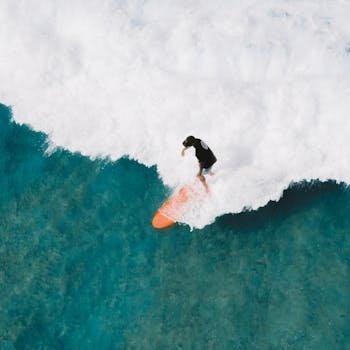Florida Surfer’s Close Call: When a Spinner Shark Becomes Airborne
Imagine paddling out for a relaxing surf session in New Smyrna Beach, Florida, when suddenly, BAM! A spinner shark leaps out of the water and smacks you right in the face. Sounds like something out of a movie, right? Well, for one Florida surfer, this became a startling reality recently. This incident, captured on video, has reignited the conversation about shark encounters and how to stay safe in the water. But before you swear off surfing forever, let’s dive into what happened, why it happened, and, most importantly, what you can do to minimize your risk.
In this blog post, we’ll explore the fascinating world of spinner sharks, discuss their behavior, and delve into the specifics of this unusual encounter. We’ll also provide practical surf safety tips to help you stay informed and prepared, ensuring your next surf session is more about catching waves than dodging airborne sharks. Prepare to learn about:
- The surprising facts about spinner sharks and their acrobatic behavior.
- The environmental factors that might contribute to these encounters.
- Essential surf safety tips to reduce your risk of a shark interaction.
- Understanding shark behavior and how to react in a close encounter.
- The bigger picture: shark conservation and respecting their habitat.
Understanding the Spinner Shark: More Than Just a Jumper
The spinner shark (Carcharhinus brevipinna) is a slender, active shark found in tropical and warm-temperate waters around the world. They get their name from their characteristic spinning behavior when feeding, often leaping out of the water while rotating rapidly – sometimes several times in a row. This aerial display is typically used to disorient schools of small fish, making them easier to catch.
Spinner Shark Characteristics:
- Size: Typically 6-9 feet long.
- Diet: Primarily small fish, squid, and crustaceans.
- Habitat: Coastal waters, often near reefs and drop-offs.
- Temperament: Generally not aggressive towards humans, unless provoked or mistaken identity.
It’s crucial to remember that spinner sharks are an important part of the marine ecosystem. They help control populations of smaller fish and contribute to the overall health of the ocean. According to the Florida Museum of Natural History, spinner sharks are commonly found off the coast of Florida, especially during their migrations. While shark attacks are relatively rare, Florida consistently ranks among the states with the most reported incidents, highlighting the importance of understanding and respecting these creatures.
Why the Airborne Attack? Explaining the Unusual Encounter
The recent incident in New Smyrna Beach is undoubtedly unusual. While spinner sharks are known for their jumping abilities, directly impacting a surfer is not typical behavior. Several factors could have contributed to this rare event:
Possible Explanations:
- Feeding Frenzy: The shark may have been actively feeding on a school of fish near the surface, and the surfer was simply in the wrong place at the wrong time. The shark’s focus would have been on the fish, not the surfer.
- Poor Visibility: Murky water conditions can reduce visibility, making it difficult for sharks to distinguish between prey and other objects.
- Mistaken Identity: From below, a surfer paddling on a board might resemble a seal or other marine mammal, potentially triggering a predatory response, though extremely unlikely with spinner sharks.
- Accidental Collision: It’s possible the shark simply misjudged its jump and accidentally collided with the surfer.
It’s important to note that shark attacks, especially unprovoked ones, are still statistically rare. According to the International Shark Attack File (ISAF), the chances of being attacked by a shark are incredibly low. However, understanding the potential reasons behind such encounters can help us take appropriate precautions.
Surf Safety: Practical Tips to Minimize Your Risk
While completely eliminating the risk of a shark encounter is impossible, there are several steps you can take to significantly reduce your chances of having a negative experience. Here are some practical surf safety tips:
Essential Surf Safety Tips:
- Surf in Groups: Sharks are less likely to approach a group of people.
- Avoid Dawn and Dusk: These are peak feeding times for many sharks.
- Don’t Surf Near Fishing Activity: Bait and chum can attract sharks.
- Avoid Murky Water: Reduced visibility increases the risk of mistaken identity.
- Be Aware of Your Surroundings: Pay attention to signs of baitfish or other marine life activity.
- Don’t Wear Shiny Jewelry: The reflection can mimic the scales of a fish.
- Learn About Local Shark Activity: Check with local authorities or surf shops for recent sightings or warnings.
- If You See a Shark, Remain Calm: Slowly paddle away from the area. Avoid splashing or erratic movements.
Beyond these tips, consider investing in shark deterrent technologies, such as shark repellent surfboards or personal electronic deterrents. While their effectiveness can vary, they may provide an added layer of protection. Remember, being informed and proactive is key to staying safe in the water.
Respecting the Ocean: Shark Conservation and Coexistence
It’s easy to feel fear and animosity towards sharks after hearing about encounters like the one in Florida. However, it’s crucial to remember that sharks are not mindless predators. They are an integral part of the marine ecosystem, and their populations are facing numerous threats, including overfishing, habitat destruction, and climate change.
Supporting Shark Conservation:
- Educate Yourself: Learn about the different species of sharks and the challenges they face.
- Support Sustainable Seafood: Choose seafood options that are harvested responsibly and do not contribute to shark finning or bycatch.
- Reduce Your Carbon Footprint: Climate change is impacting ocean ecosystems, including shark habitats.
- Support Conservation Organizations: Donate to or volunteer with organizations that are working to protect sharks and their environment.
By understanding and respecting sharks, we can coexist peacefully and ensure the health of our oceans for future generations. Remember, the ocean is their home, and we are visitors. Let’s strive to be responsible and respectful visitors.
Conclusion: Staying Safe and Appreciating Sharks
The story of the Florida surfer being struck by a spinner shark is a reminder of the power and unpredictability of nature. While such incidents are rare, they underscore the importance of being aware of our surroundings and taking appropriate precautions when entering the ocean. By understanding spinner shark behavior, following surf safety guidelines, and supporting shark conservation efforts, we can minimize our risk and contribute to the health of our marine ecosystems.
Before you head out for your next surf session, take a moment to review the tips we’ve discussed. Check local conditions, surf with a buddy, and be mindful of your surroundings. And remember, while sharks deserve our respect and caution, they also deserve our protection. Learn more about shark conservation efforts by visiting the websites of organizations like the Shark Research Institute or the World Wildlife Fund.
Now, go catch some waves – responsibly!






